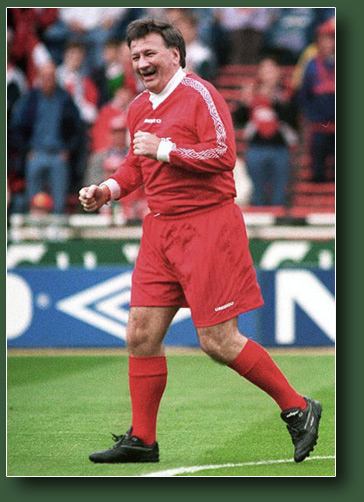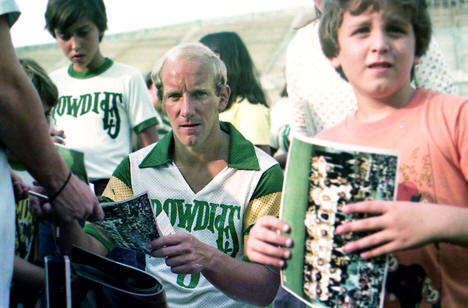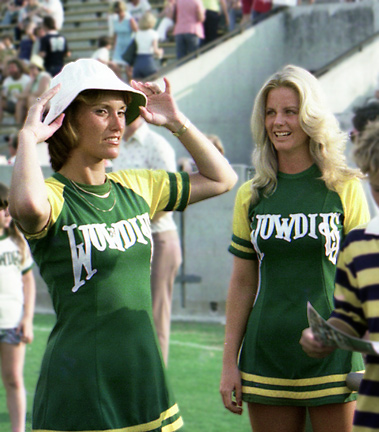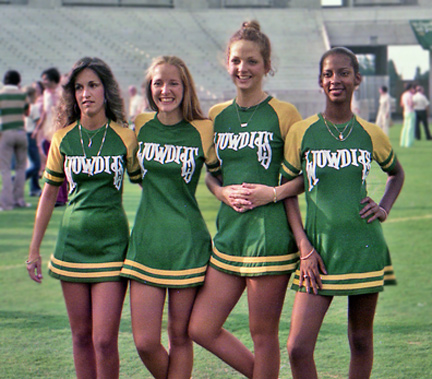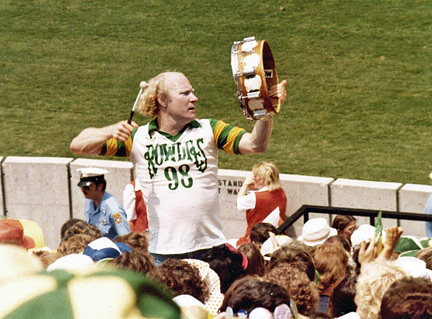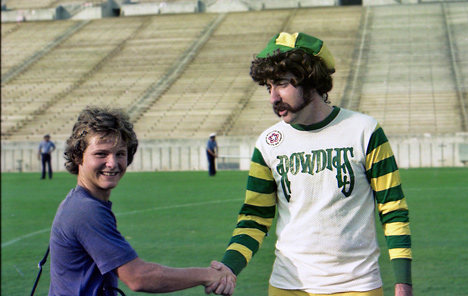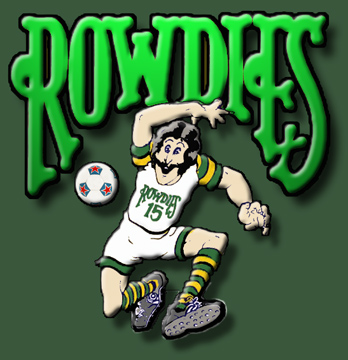
1976 Tampa Bay Rowdies "Fannies" Day |
||||||||
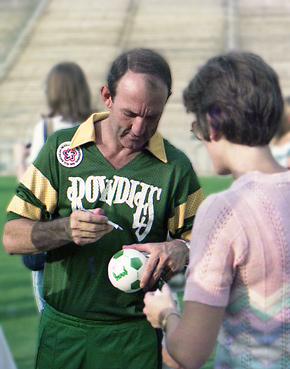 |
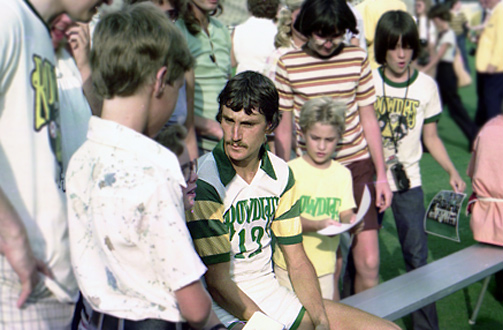 |
|||||||
|
Coach Eddie Firmani
Eddie Firmani was one of the
great South African players to play for Charlton. He scored 89 goals in
177 appearances in his two spells at The Valley, although he was often
played out of position. When he was transferred to Sampdoria he was
the most expensive Football League player ever. He was manager of Charlton
from September 1967 to March 1970. Although this was an up-and-down spell,
he went on to subsequent success in the North American Soccer League. |
Derek Smethurst chats
with a young fannie "What do you mean your favorite player is Rodney Marsh?!?!?"
Now an accomplished author and sports consultant, Derek has served as Technical Advisor / Trainer at the University of South Florida and MLS/Youth Soccer. He now lives in Valrico, FL, and runs a soccer camp. Read about Derek's career and success in the NASL, and see more pictures. |
|||||||
|
Mark "Jaws" Lindsay Mark was born March 6, 1955 in London, England and played for a time in South Africa and with then 3rd Division Crystal Palace when loaned to the Rowdies in 1975. Before there
was the book and movie about the shark, there was Mark "Jaws" Lindsay.
Mark was the life of the party on Tampa Bay bus and plane trips, Fannies
functions or any get-together. Known for his constant and witty chatter on
and off the field, his non-stop dialogue earned him his nickname.
Lindsay joined the Rowdies in order to gain experience and confidence to take with him back to England. A tireless midfielder and the speediest on the Rowdies' '75 roster, Lindsay was relentless in his pursuit of regaining the ball. He continually led the team in steals, averaging 13 takeaways per game in his time with the Rowdies. His sneak attacks on unsuspecting opponents helped swing momentum to the Rowdies' side, start fast breaks and generally demoralize the opposition. Aug. 20,
1975 article: May 19, 1977
article: |
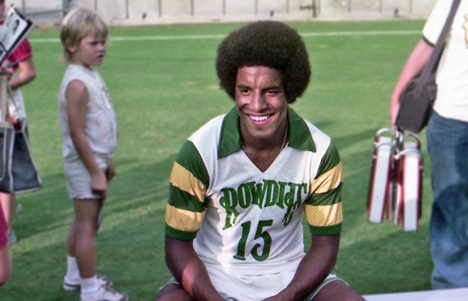
Mark played
in 59 games from 1975 through 1977 for the Rowdies before his moving on to
the Houston Hurricane in 1978 where he scored 4 goals and 4 assists.
He played there 2 games in the '79 season before joining the California
Surf where he scored 10 goals and 18 assists outdoors from 1979 through
1981. He also played indoors for the Surf, tallying 15 goals and 30
assists.
Lindsay & Glover celebrate In 1982, Mark joined the Jacksonville Tea Men before playing 2 seasons in the MISL, one with the Baltimore Blast in '82-'83 and one with the LA Lazers for '83-'84. He ended his playing career with the Rowdies in 1984. |
|
Arnold "El Grandóte" Mausser Arnold "Arnie" Mausser was born February 28, 1954 in Brooklyn, New York. During his career he played with 8 different NASL teams from 1975-1984 and is a member of the National Soccer Hall of Fame. Mausser is considered to be one of the finest goalkeepers the United States has ever produced. He is known as the trailblazer for future US goalkeepers such as Kasey Keller, Tim Howard, and Brad Friedel. He was a big man (standing 6' 5") who threw with his right hand, but kicked with his left foot. Mausser was one of the few goalkeepers who was not a product of the America college system. Arnie grew up in Brooklyn with two younger brothers, and played numerous sports, his favorite being basketball. In the eighth grade he began playing soccer and because of his size, played goalkeeper. As he got older he trained with numerous local teams, eventually catching the eye of the coach of the Rhode Island Oceaneers of the American Soccer League (ASL). He signed with the team in 1974 and played a single season, going unbeaten at 24-0-1. In 1975, Mausser joined the Hartford Bicentennials of the North American Soccer League (NASL), tending the net for all but 15 minutes of the season. He remained with the team for only a single season before moving to the Tampa Bay Rowdies for the 1976 season. Arnie logged 2,162 minutes in 1976, making 200 saves and finishing 4th in the league with a 1.17 goals against average. In 1976, he was honored with the Pele award on national television as top American player in the NASL.
After one season, he moved from Vancouver to the Colorado Caribous. After one season in Colorado, he moved to the Fort Lauderdale Strikers. Then he was traded from the Strikers to the New England Teamen during the 1980 season. At the end of the season, the Teamen moved to Jacksonville, Florida, where Mausser spent the next two seasons as part of the Jacksonville Tea Men. Mausser's strong play earned him the starting goalkeeper position for the national team with which he earned 35 caps, for shut outs, between 1975 and 1985. He generally played well for the national team, earning 10 shutouts. In 1985 the U.S. just missed qualifying for the 1986 FIFA World Cup in the last home match with Costa Rica in Torrance, California. Mausser played one more game for the national team, against by England on June 16. Mausser was a member of Team America, the short lived USSF attempt to form the United States men's national soccer team into a quasi-professional team. |
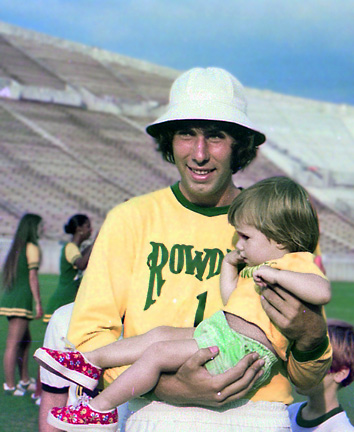 In 1984, he played the NASL's last outdoor season back with the Rowdies. When the NASL folded, he briefly played with the Kansas City Comets of the Major Indoor Soccer League (MISL). He would also play a season with the Buffalo Stallions of the MISL. In 1988 he moved to the Fort Lauderdale Strikers, now of the American Soccer League and then to the Albany Capitals of the American Professional Soccer League for the 1990 season. He ended his career back with the Strikers for another two seasons before retiring in 1992. Arnie got his nickname of "El Grandóte" (The Big One) from Mexican soccer fans during his exploits with the US National Team. In 1986, Winston Dubose and Mausser played in Tampa's "1986 Coca-Cola Classic Int'l Soccer Series" as guests on a team consisting of the Queens Park Rangers. The team, who at the time included Steve and Roy Wegerle, had varying rosters and coaches for each game in the series, most notably, coaches Rodney Marsh and Pele. Other Rowdies included Wes McLeod, Tatu, Mike McConnell and Mannie Rojas.
Mausser was inducted in the National Soccer Hall of Fame in 2003. He is now the president of Sun Flare Marketing, a computer systems design service specializing in website hosting, design, and brochures in Ft. Meyers, Florida.
|



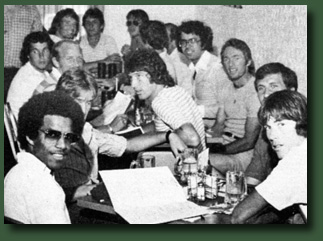
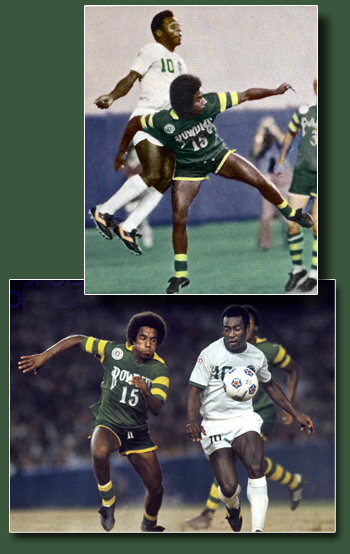 Mark's
continuous motion and ability to stay with his man all the way across the
field, combined with his speed, made him a valuable member of the Rowdies
squad. His versatility allowed him to play a number of positions,
including midfield and defender.
Mark's
continuous motion and ability to stay with his man all the way across the
field, combined with his speed, made him a valuable member of the Rowdies
squad. His versatility allowed him to play a number of positions,
including midfield and defender.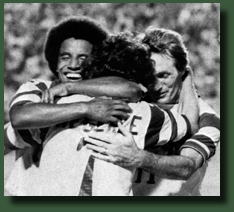
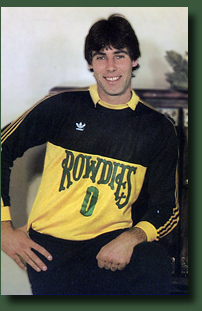 His excellent play
with the Rowdies (6 shutouts and 28 goals scored against him in 24 games)
led to his selection as a first team NASL All Star. Despite his success
with the Rowdies, coach Eddie Firmani preferred English
goalkeeper Paul Hammond who had spent the 1975 season with the Rowdies. As
a result, Firmani traded Mausser in 1977 to the Vancouver Whitecaps after
the Rowdies signed Hammond.
His excellent play
with the Rowdies (6 shutouts and 28 goals scored against him in 24 games)
led to his selection as a first team NASL All Star. Despite his success
with the Rowdies, coach Eddie Firmani preferred English
goalkeeper Paul Hammond who had spent the 1975 season with the Rowdies. As
a result, Firmani traded Mausser in 1977 to the Vancouver Whitecaps after
the Rowdies signed Hammond.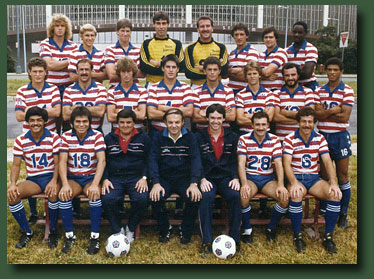
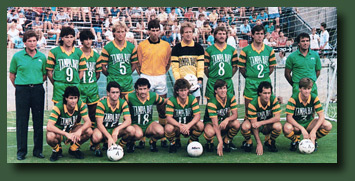
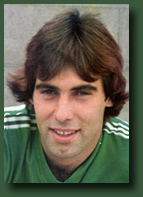
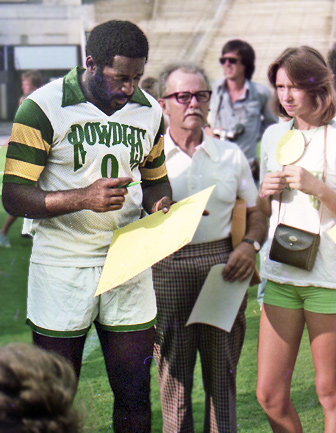
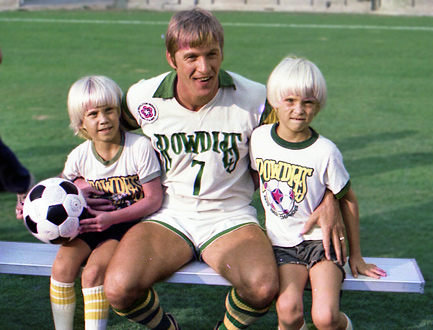
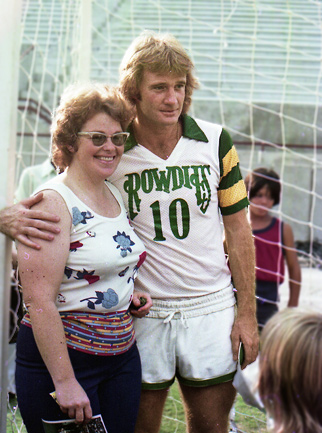
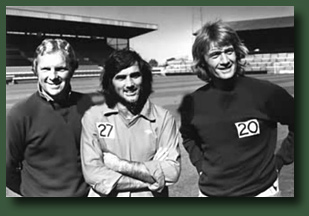
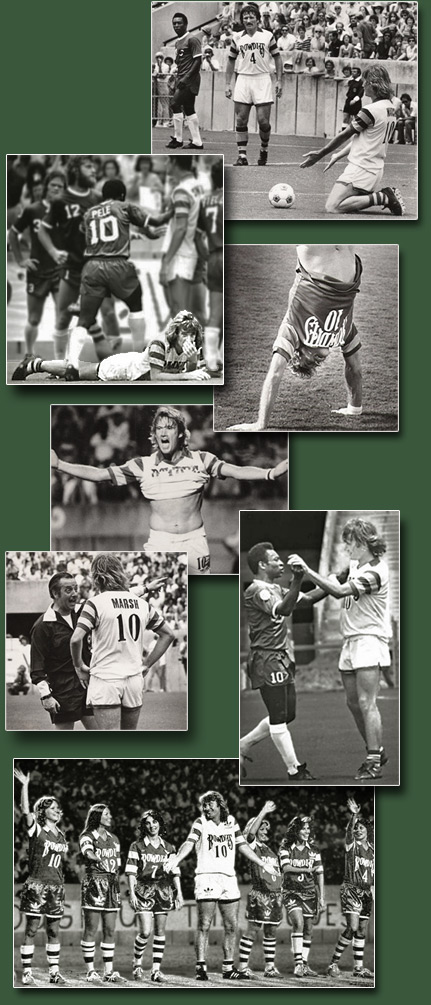
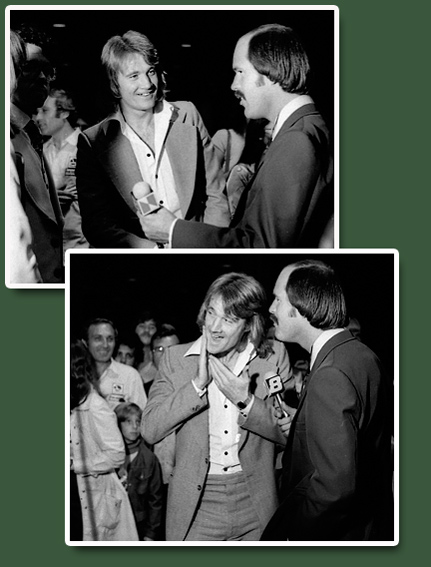
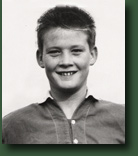
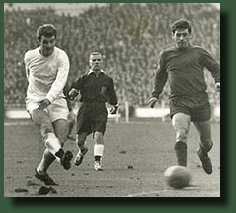 Marsh was
one of a generation of highly talented "maverick" players that emerged in
English football during the 1960s and 1970s. He began his career as
a 15-year-old youth player at West Ham and and a year later went on to
play for Fulham, for whom he made his debut in 1963. During his time
at Fulham, in the act of heading a spectacular goal, a collision with a
goal post and an opposing defender cost him the hearing in his left ear.
The result: an outwardly engaging but personal lifetime habit of tilting
his head to one side during conversation.
Marsh was
one of a generation of highly talented "maverick" players that emerged in
English football during the 1960s and 1970s. He began his career as
a 15-year-old youth player at West Ham and and a year later went on to
play for Fulham, for whom he made his debut in 1963. During his time
at Fulham, in the act of heading a spectacular goal, a collision with a
goal post and an opposing defender cost him the hearing in his left ear.
The result: an outwardly engaging but personal lifetime habit of tilting
his head to one side during conversation. 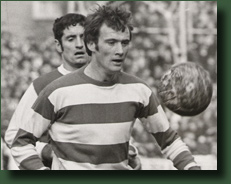 honest hard working forwards
suddenly had a skillful forward with bewitching trickery that mesmerized
opposing defenses. With his teammates help, Rodney was able to use his
full repertoire of tricks to dismantle most teams. In the league, the
Rangers scored 103 goals, 30 of them were by Rodney in 41 appearances.
honest hard working forwards
suddenly had a skillful forward with bewitching trickery that mesmerized
opposing defenses. With his teammates help, Rodney was able to use his
full repertoire of tricks to dismantle most teams. In the league, the
Rangers scored 103 goals, 30 of them were by Rodney in 41 appearances.
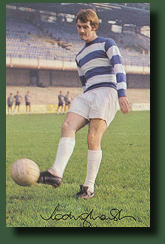
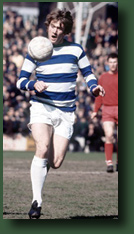 For a big
man (over 6ft) he had incredible ball control and had a trick where he
could pass to himself as he was running. He used to pass with his
right foot but the ball would hit his left foot as he was running, making
the ball veer the other way, which threw the defense and he could amble
towards goal.
For a big
man (over 6ft) he had incredible ball control and had a trick where he
could pass to himself as he was running. He used to pass with his
right foot but the ball would hit his left foot as he was running, making
the ball veer the other way, which threw the defense and he could amble
towards goal. 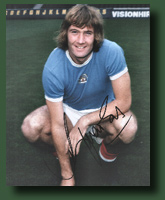 In 1972 he
signed with Manchester City for a then club record transfer fee of
£200,000. Despite his claim that his style simply did not suit that of the
team, he became one of City's star players, scoring 19 goals in 1972-73
and often dazzling the crowd with his skills. Marsh led the club to a
League Cup final in 1974, but were beaten by the Wolverhampton Wanderers.
He left the club shortly into the 1974-75 season after disagreements with
new manager Tony Book.
In 1972 he
signed with Manchester City for a then club record transfer fee of
£200,000. Despite his claim that his style simply did not suit that of the
team, he became one of City's star players, scoring 19 goals in 1972-73
and often dazzling the crowd with his skills. Marsh led the club to a
League Cup final in 1974, but were beaten by the Wolverhampton Wanderers.
He left the club shortly into the 1974-75 season after disagreements with
new manager Tony Book.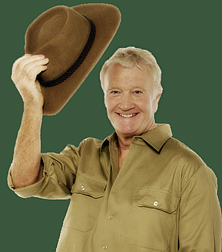
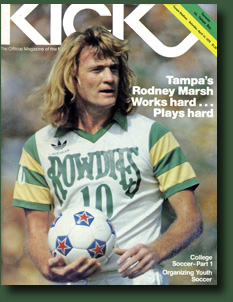 Marsh retired
after 1979, and coached the New York United and Carolina Lightnin' teams
in the ASL, before returning to the Rowdies to coach their final NASL
season in 1984. He was head coach from 1984 to 1986, and was the team's
chief executive for 11 years. In 1986, he came out of retirement to
play one last season with the Rowdies, this time with the American Indoor
Soccer Association (AISA). Marsh played in twenty games during the
1985-1986 season, scoring 13 goals.
Marsh retired
after 1979, and coached the New York United and Carolina Lightnin' teams
in the ASL, before returning to the Rowdies to coach their final NASL
season in 1984. He was head coach from 1984 to 1986, and was the team's
chief executive for 11 years. In 1986, he came out of retirement to
play one last season with the Rowdies, this time with the American Indoor
Soccer Association (AISA). Marsh played in twenty games during the
1985-1986 season, scoring 13 goals.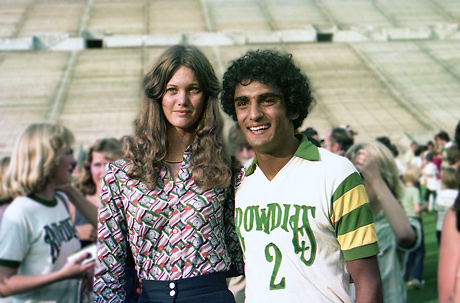
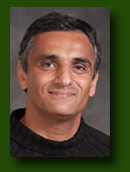
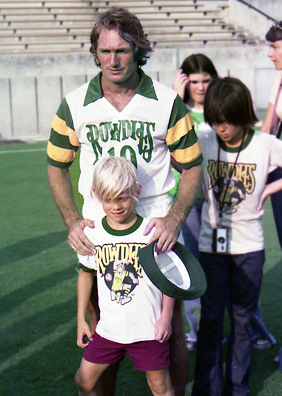
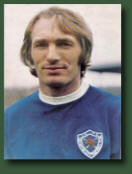 In
1967 he was transferred for £80,000 to Leicester City, an amount
which at the time represented an English record for a winger. There,
he captured the imaginations and pulse-rates of the Leicester Foxes
supporters.
In
1967 he was transferred for £80,000 to Leicester City, an amount
which at the time represented an English record for a winger. There,
he captured the imaginations and pulse-rates of the Leicester Foxes
supporters.
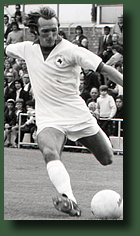 With
electric pace, superb ball control and wing trickery Lenny Glover was
destined to become a City legend. Described as the best uncapped winger in
the world and despite calls from many quarters, Lenny was never granted an
England Cap. He did, however, help the Foxes to an F.A. cup final
appearance; two cup semi-finals; a Division Two Championship; and a
Charity Shield win against Liverpool. At Leicester City, for 8 full
seasons and 2 games into a 9th season in 1976, he scored 38 goals.
In his combined career with Charlton and Leicester, Glover played 430
total games.
With
electric pace, superb ball control and wing trickery Lenny Glover was
destined to become a City legend. Described as the best uncapped winger in
the world and despite calls from many quarters, Lenny was never granted an
England Cap. He did, however, help the Foxes to an F.A. cup final
appearance; two cup semi-finals; a Division Two Championship; and a
Charity Shield win against Liverpool. At Leicester City, for 8 full
seasons and 2 games into a 9th season in 1976, he scored 38 goals.
In his combined career with Charlton and Leicester, Glover played 430
total games.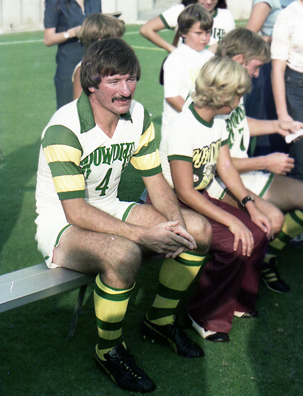
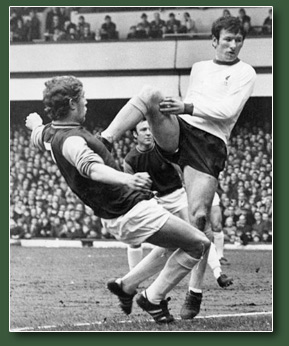 Smith won every major club
honor during his 18 years with Liverpool.
Smith won every major club
honor during his 18 years with Liverpool.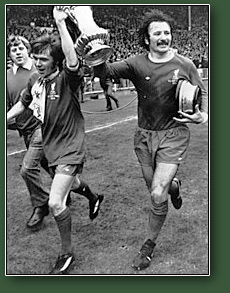
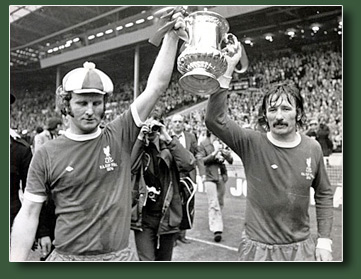
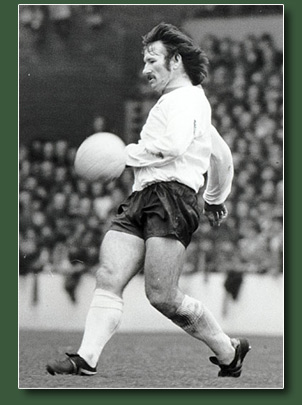 After
the success of 1966 there then followed a barren period for Liverpool in
the late 1960s and after a disastrous cup defeat at Vicarage Road to
Watford in February 1970, Shankly decided to dismantle the team and build
a new, younger side. Smith was given the honor of club captaincy and led
the team to the 1971 FA Cup final, which Liverpool lost to Arsenal.
After
the success of 1966 there then followed a barren period for Liverpool in
the late 1960s and after a disastrous cup defeat at Vicarage Road to
Watford in February 1970, Shankly decided to dismantle the team and build
a new, younger side. Smith was given the honor of club captaincy and led
the team to the 1971 FA Cup final, which Liverpool lost to Arsenal.